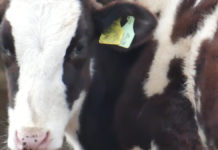世界動物保健機関(OIE)の陸生動物衛生規約第7.5 7.4条で、屠畜における豚の二酸化炭素スタニングは動物を苦しめるということが明記されており、研究中であることが示されています。
豚は二酸化炭素に晒された後、即座には無意識になりません*1。 屠畜場で、豚が80%~90%の二酸化炭素が充填されたチャンバーに降ろされた時、二酸化炭素を吸引し始めてから意識を失うまで30~60秒掛かる可能性があるのです*2。
二酸化炭素は豚にとってかなり有害であることがわかっています*3,4,6。
二酸化炭素の吸引は、粘膜への刺激によって急性の呼吸器系の苦痛を引き起こします*7。呼吸器系の苦痛は、息切れ、あえぎ*4、窒息と言った過度呼吸を引き起こします*2。また豚は二酸化炭素に晒された時、筋興奮を示し、鳴き声をあげます。
これらは全て意識を失う前に起こっています*2,4。デンマークとスペインの共同研究者らは、以下のように結論づけています*2。
「動物が意識がある中でこれらの行動が起こるという事実は、二酸化炭素麻酔への誘導が即時ではないという証拠である。豚は恐怖、痛み、および/またはガスに暴露された際のストレスに苦しんでいる」
外から見ているだけの人間にとって、チャンバーに追い込むだけという作業は気持ちが楽です。しかし、それはアニマルウェルフェアとは遠いものです。
豚は二酸化炭素を察知し、90%の豚が二酸化炭素にさらされるよりも絶水が72時間続く法を選ぶという研究もあります*8。豚たちは死の危険を察知しており、二酸化炭素にさらされることはストレスであり恐怖であることは確実です。
今も豚のより人道的な屠畜方法は研究が続いています。ナイトロジン、アルゴンの混合などが研究されている様子です。
日本では二酸化炭素単体の屠殺方法が動物愛護のためにもなるといった誤った知識が一部であり、懸念しています。二酸化炭素単体での屠畜方法は、今すぐに廃止されるべき方法なのです。
*1 Llonch P, Dalmau A, Rodriguez P, Manteca X, and Velarde A. 2012. Aversion to nitrogen and carbon dioxide mixtures for stunning pigs
*2 Rodriquez P, Dalmau A, Ruiz-de-la-Torre JL, Manteca X, Jensen EW, Rodriguez B, Litvan H, and Velarde A. 2008. Assessment of unconsciousness during carbon dioxide stunning in pigs.
*3 Raj ABM and Gregory NG. 1995. Welfare implications of the gas stunning of pigs 1. Determination of aversion to the initial inhalation of carbon dioxide or argon.
*4 Opinion of the Scientific Panel on Animal Health and Welfare on a request from the Commission related to welfare aspects of the main systems of stunning and killing the main commercial species of animals. 2004.
*6Velarde A, Cruz J, Gispert M, Carrión D, Torre RJ, Diestre A, and Manteca X. 2007. Aversion to carbon dioxide stunning in pigs: effect of carbon dioxide concentration and halothane genotype
*7 Raj ABM and Gregory NG. 1996. Welfare implications of the gas stunning of pigs 2. Stress of induction of anaesthesia.
*8 Scientific Report of the Scientific Panel for Animal Health and Welfare on a request from the Commission related to welfare aspects of animal stunning and killing methods. 2004. Welfare aspects of animal stunning and killing methods. The EFSA Journal 1-241.
















